
Principles and Applications of Asymmetric Synthesis
.pdf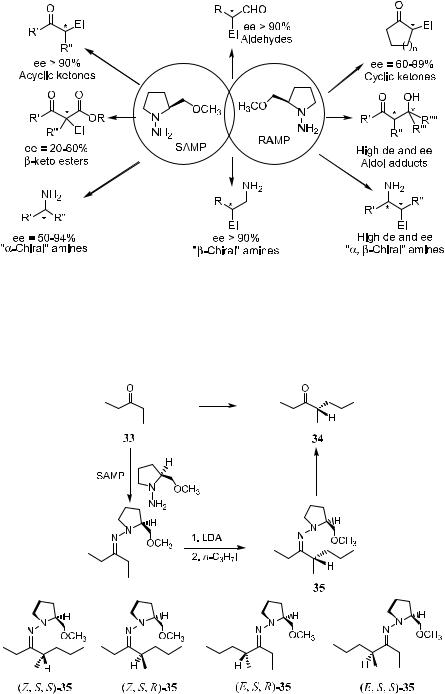
90 a-ALKYLATION AND CATALYTIC ALKYLATION OF CARBONYL COMPOUNDS
Figure 2±3. Synthetic scope of the SAMP/RAMP-hydrazone method.
Scheme 2±22
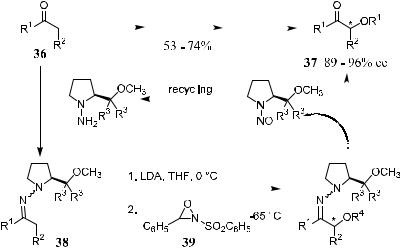
|
|
|
|
|
|
|
|
2.2 CHIRALITY TRANSFER |
91 |
|||
|
|
|
|
|
|
|
|
|
|
|
|
|
|
|
|
|
|
|
|
|
|
|
|
|
|
|
|
|
|
|
|
|
|
|
|
|
|
|
|
|
|
|
|
|
|
|
|
|
|
|
|
|
|
|
|
|
|
|
|
|
|
|
|
|
|
|
|
|
|
|
|
|
|
|
|
|
|
Scheme 2±23
Another application of the hydrazone method is the preparation of a- hydroxy carbonyl compounds (R4 ˆ H in 37). The aldehydes/ketones 36 are ®rst transformed into their corresponding SAMP-hydrazones 38, followed by deprotonation with t-butyllithium or LDA in THF. The resulting anion undergoes facile oxidation by treatment with 2-phenylsulfonyl-3-phenyloxaziridine (39), and the product can be obtained with good to excellent enantioselectivity (Scheme 2±23).39b
Several reviews and research papers discussing the application and extension of this method have appeared.40 For example, Weber et al.41 reported an interesting result in which cerium acted as a counterion in the modi®ed proline auxiliary (SAMEMP 40) for selective addition of organocerium reagents to hydrazones. The initial adduct was trapped with either methyl or benzyl chloroformate to a¨ord the stable N-aminocarbonate 41 (Scheme 2±24). From this example readers can see that this proline chiral auxiliary can be used not only for a-alkylation but also for nucleophilic addition, which is discussed in detail later.
In the study of Weber et al.,41 a series of proline-derived hydrazones were prepared, and the reactions of the hydrazones with organocerium reagents were examined. It is clear from the table in Scheme 2±24 that the diastereoselectivity of the examined reactions depends on the nature of the side chain. (S)-1-amino- 2-(2-methoxyethoxymethyl) pyrrolidine (40) gave the highest selectivity for various nucleophiles.
2.2.3.6 Oxazoline Systems. The 2-oxazoline system has long been known42 and can readily be prepared43 from 2-aminoethanol derivatives and carboxylic acids. This compound has served as a potential precursor for elaborated car-
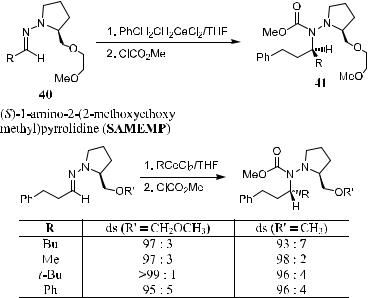
92 a-ALKYLATION AND CATALYTIC ALKYLATION OF CARBONYL COMPOUNDS
Scheme 2±24. SAMEMP mediated reactions.
boxylic acids because of its ease of formation,44 the availability of the starting material, and the stability of the compounds in the face of a wide range of temperatures and reagents. The 2-position of this oxazoline compound can easily be metalated with butyl lithium (THF, ÿ78 C), and the resulting lithio derivative can be alkylated with various electrophiles (alkyl halides, carbonyl compounds, and epoxides). Oxazoline-mediated asymmetric synthesis was ®rst reported in 1974.45 Since then, great e¨ort has been expended in the development and application of these versatile substrates.
Metalation of 42 using n-butyllithium or LDA provides an azaenolate that exists as a mixture of (Z)- and (E )-43. Alkylation followed by hydrolysis yields the optically active a,a-disubstituted carboxylic acid (S)-44 in 72±80% ee (Scheme 2±25 and Table 2±7).
Lithiated chiral oxazolines have been shown to react with various electrophiles, generating a new asymmetric center with considerable bias. This process has led to the synthesis of optically active a-alkylalkanoic acids,47 a- hydroxy(methoxy)alkanoic acids,48 b-hydroxy(methoxy)alkanoic acids,49 a- substituted g-butyrolactones,50 and 2-substituted-1,4-butanediols (Fig. 2±4).50
The oxazoline methodology can be applied in the total synthesis of natural products. For example, in the course of the total synthesis of European pinesaw ¯y pheromone 47, the key intermediate, chiral a-methyl carboxylic acid 46, was prepared via the reaction of a-lithioethyloxazoline with n-octyl iodide. The product 2-methyl decanoic acid 46 was obtained, after hydrolysis, in 72% ee (Scheme 2±26).51

2.2 CHIRALITY TRANSFER |
93 |
Scheme 2±25. Alkylation of chiral oxazolines to carbonyl acids 44.
TABLE 2±7. Alkylation of Chiral Oxazolines to Carbonyl Acids 4446
Entry |
R |
R0X |
ee (%) |
Con®g. |
Overall Yield (%) |
1 |
Me |
EtI |
78 |
S |
84 |
2 |
Et |
Me2SO4 |
79 |
R |
83 |
3 |
Me |
n-PrI |
72 |
S |
79 |
4 |
n-Pr |
Me2SO4 |
72 |
R |
74 |
5 |
Me |
PhCH2Cl |
74 |
S |
62 |
6 |
PhCH2 |
Me2SO4 |
78 |
R |
75 |
ee ˆ Enantiomeric excess; R ˆ R in 42; R0X ˆ R0X in Scheme 2±25.
Reprinted with permission by Am. Chem. Soc., Ref. 46.
In addition to the reactions discussed above, a,b-unsaturated oxazolines can also act as chiral electrophiles to undergo conjugated addition of organolithium reagent to give optically active b,b-disubstituted carboxylic acids.52 The vinyl oxazolines 48 are prepared using the two methods outlined in Scheme 2±27.
After treating 48 with various organolithium reagents and the subsequent hydrolysis of the thus formed products, a variety of b,b-disubstituted propionic acids 49 can be obtained in good yield with high enantioselectivity (Table 2±8).
2.2.3.7 Acylsultam Systems. Oppolzer et al.53 developed a general route to enantiomerically pure crystalline a,a-disubstituted carboxylic acid derivatives by asymmetric alkylation of N-acylsultams. Acylsultam 50 can be readily prepared from the inexpensive chiral auxiliary sultam 53.54
Successive treatments of chiral acylsultam 50 with n-BuLi or NaHMDS and primary alkyl halides, followed by crystallization, give the pure a,a-alkylation product 52 (Scheme 2±28). Under these conditions, the formation of C-10± alkylated by-product is inevitable. It is worth mentioning, however, that product 52 can readily be separated from the C(a)-epimers by crystallization. In fact,
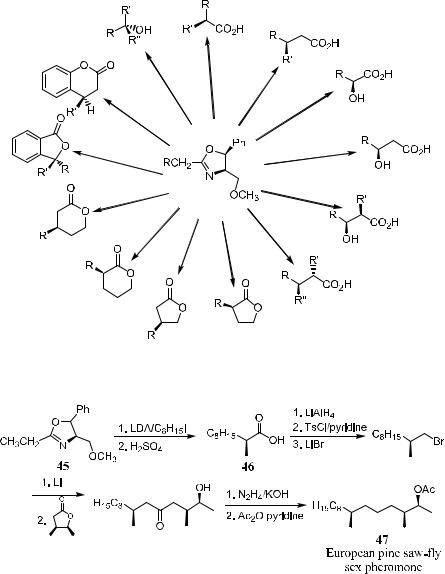
94 a-ALKYLATION AND CATALYTIC ALKYLATION OF CARBONYL COMPOUNDS
Figure 2±4. Oxazoline methodology as a tool in organic synthesis.
Scheme 2±26. Synthesis of European pine-saw ¯y pheromone.
via appropriate cleavage, enantiomerically pure alcohol 55 or carboxylic acid 54 can be obtained and the sultam can be recovered. The observed topicity is consistent with the kinetically controlled formation of chelated (Z)-enolate 51 (Scheme 2±28). In the process of alkylation of 50 to 52, the alkylating reagent attacks from the Re-face, which is opposite to the lone pair electrons on the

2.2 CHIRALITY TRANSFER |
95 |
Scheme 2±27. Preparation of b,b0-substituted carboxylic acids.
TABLE 2±8. Preparation of b; b-Disubstituted Carboxylic Acids 4952
Entry |
R |
R0 |
ee (%) |
Con®g. |
Yield (%) |
1 |
Me |
Et |
92 |
R |
30 |
2 |
Me |
Ph |
98 |
S |
34 |
3 |
i-Pr |
n-Bu |
99 |
R |
53 |
4 |
t-Bu |
n-Bu |
98 |
R |
50 |
5 |
c-hexyl |
Et |
99 |
R |
73 |
6 |
MeOCH2CH2 |
n-Pr |
99 |
S |
50 |
7 |
o-MeOPh |
n-Bu |
95 |
R |
75 |
|
|
|
|||
ee ˆ Enantiomeric excess; R ˆ R in Scheme 2±27; R0 |
ˆ R0 in Scheme 2±27. |
|
|||
nitrogen atom. Table 2±9 illustrates the alkylation results using various halides as electrophiles.
In addition to the asymmetric induction mentioned above, sultam 53 can also be used to prepare enantiomerically pure amino acids (Scheme 2±29 and Table 2±10).55 Me3Al-mediated acylation of 53 with methyl N-[bis(methylthio)- methylene]glycinate 56 provided, after crystallization, glycinate 57, which can serve as a common precursor for various a-amino acids. In agreement with a kinetically controlled formation of chelated (Z)-enolates, alkylation happened from the Si-face of the a-C, opposite to the lone pair electrons on the sultam nitrogen atom. High overall yield for both the free amino acid 58 and the
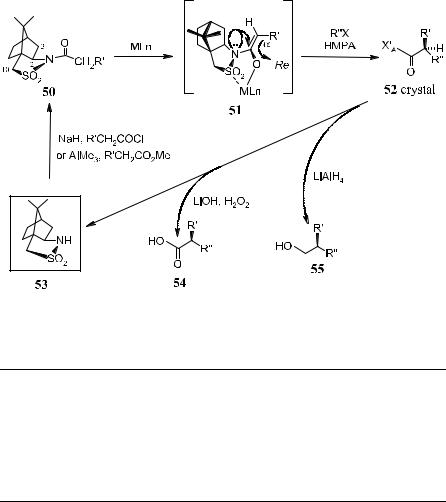
96 a-ALKYLATION AND CATALYTIC ALKYLATION OF CARBONYL COMPOUNDS
Scheme 2±28. Reprinted with permission by Pergamon-Elsevier, Ref. 53.
TABLE 2±9. Asymmetric Alkylation of 50
R0 |
R00X |
ML |
de (%, crude) |
de (%, crystal) |
Me |
PhCH2I |
NHDMS |
96.5 |
98.4 |
Me |
PhCH2I |
KHDMS |
92.9 |
|
Me |
PhCH2I |
BuLi |
96.9 |
98.5 |
Me |
CH2 bCHCH2I |
NHDMS |
94.2 |
94.5 |
Me |
CH2 bCHCH2I |
BuLi |
96.6 |
96.6 |
Me |
CH2 bCHCH2Br |
BuLi |
98.8 |
>99 |
Me |
HCcCCH2Br |
BuLi |
98.3 |
>99 |
de ˆ Diastereomeric excess; ML ˆ MLn in Scheme 2±28; R0 ˆ R0 in 50; R00X ˆ R00X in Scheme 2±28.
readily separable sultam 53 can be obtained via mild acidic N-deprotection of 59 and subsequent gentle saponi®cation. Analogous alkylation of the glycinate equivalent a¨ords a variety of a-amino acids (Table 2±10).
Sultam 53 has proved to be an excellent chiral auxiliary in various asymmetric C±C bond formation reactions. One more example of using sultam 53 is the asymmetric induction of copper(I) chloride-catalyzed 1,4-addition of alkyl magnesium chlorides to a,b-disubstituted (E )-enesultams 60. Subsequent protonation of the reaction product gives compound 61c as the major product (Scheme 2±30 and Table 2±11).56
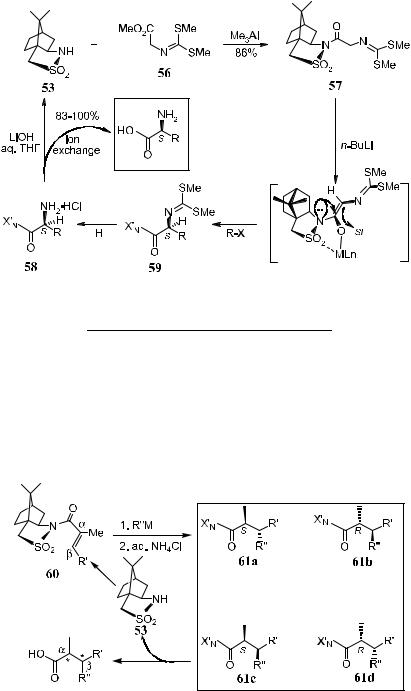
2.2 CHIRALITY TRANSFER |
97 |
Scheme 2±29
TABLE 2±10. Alkylation of Glycinate Equivalents
RX |
ee (%) |
|
|
MeI |
>99.8 |
PhCH2I |
>99.8 |
CH2 bCHCH2I |
>99.8 |
t-BuOOCCH2Br |
>99.8 |
(CH3)2CHCH2I |
>99.8 |
(CH3)2CHI |
99.5 |
ee ˆ Enantiomeric excess; RX ˆ R-X in Scheme 2±29.
Scheme 2±30

98 a-ALKYLATION AND CATALYTIC ALKYLATION OF CARBONYL COMPOUNDS
TABLE 2±11. Sultam 53 in the Preparation of 60c
R0 |
R00 |
Cu(I) salt |
Ratio (a:b:c:d) |
Crystal purity (%) |
Con®g. |
Me |
Bu |
CuCl |
2.1:0:86.3:11.6 |
97.7 |
2S,3S |
Me |
Bu |
CuCN |
2.5:0:83.7:14.4 |
Ð |
2S,3S |
Me |
Et |
CuCl |
2.3:0:85.4:12.3 |
98.6 |
2S,3S |
Et |
Bu |
CuCl |
0:0:91.5:8.5 |
99.8 |
2S,3S |
Bu |
Et |
CuCl |
0:0:97.3:2.7 |
99 |
2S,3R |
TBSOCH2 |
Bu |
CuCl |
0:0:97.0:3.0 |
99.4 |
2S,3S |
Bu |
Me |
CuCl |
10.5:8.2:68.6:12.7 |
Ð |
2S,3R |
Me |
Ph |
CuCl |
2.7:3.2:72.5:21.6 |
Ð |
2S,3R |
R0 ˆ R0 in Scheme 2±30; R00 ˆ R00 in Scheme 2±30.
For a review of sultam chemistry, interested readers can refer to Oppolzer's article57 on ``Camphor as a Natural Source of Chirality in Asymmetric Synthesis.''
2.3PREPARATION OF QUATERNARY CARBON CENTERS
The previous section discussed chelation enforced intra-annular chirality transfer in the asymmetric synthesis of substituted carbonyl compounds. These compounds can be used as building blocks in the asymmetric synthesis of important chiral ligands or biologically active natural compounds. Asymmetric synthesis of chiral quaternary carbon centers has been of signi®cant interest because several types of natural products with bioactivity possess a quaternary stereocenter, so the synthesis of such compounds raises the challenge of enantiomer construction. This applies especially to the asymmetric synthesis of amino group±substituted carboxylic acids with quaternary chiral centers.
A new method for the stereoselective introduction of a quaternary asymmetric carbon atom was developed by Meyers, based on the interactive lithiation and alkylation of chiral bicyclic lactam 62±64 derived from g-keto acids and (S)-valinol. Although the initial step proceeds with poor diastereocontrol, the second alkylation can proceed with excellent endo-selectivity. Chiral bicyclic lactams have now proved to be useful compounds for synthesizing a variety of chiral, nonracemic compounds containing quaternary carbons at the stereocenter. The substrates 62±64 undergo double alkylation with lithium base and two alkyl halides to yield the products with quaternary carbon centers in high diastereoselectivity. Acid treatment of the resulting compound yields enantiomerically pure g-keto acid 66,58 while reduction of the resulting compound followed by base-catalyzed aldol condensation yields the cyclic pentenone 68 with high ee (Scheme 2±31).59,60
Meyers et al. also studied the stereoelectronic and steric e¨ects of the p-facial
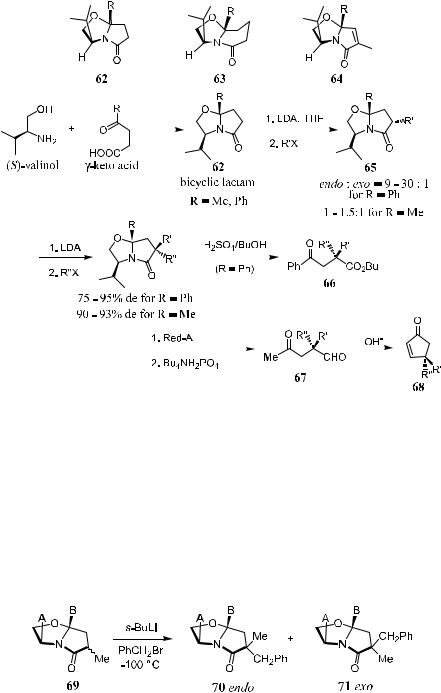
|
2.3 PREPARATION OF QUATERNARY CARBON CENTERS |
99 |
||||||||||||||
|
|
|
|
|
|
|
|
|
|
|
|
|
|
|
|
|
|
|
|
|
|
|
|
|
|
|
|
|
|
|
|
|
|
|
|
|
|
|
|
|
|
|
|
|
|
|
|
|
|
|
|
|
|
|
|
|
|
|
|
|
|
|
|
|
|
|
|
|
|
|
|
|
|
|
|
|
|
|
|
|
|
|
|
|
|
|
|
|
|
|
|
|
|
|
|
|
|
|
|
|
|
|
|
|
|
|
|
|
|
|
|
|
|
|
|
|
|
|
|
|
|
|
|
|
|
|
|
|
|
|
|
|
|
|
|
|
|
|
|
|
|
|
|
|
|
|
|
|
|
|
|
|
|
|
|
|
|
|
|
|
|
|
|
|
|
|
|
|
|
|
|
|
|
|
|
|
|
|
|
|
|
|
|
|
|
|
Scheme 2±31
addition of electrophiles to lactam enolates in order to explain the observed stereoselectivity. In previous studies, Romo and Meyers61 found that angularly placed exo-substituents imparted steric bias for endo-alkylation. Systematic replacement of the exo-alkyl and aryl substituents on bicyclic lactam 69 with hydrogen results in a drop in endo-alkylation selectivity from 98:2 to 69:31 (Scheme 2±32 and Table 2±12). However, the endo-alkylation is still preferred, even when both the A and B substituents are hydrogen. Thus, it is presumed
Scheme 2±32
